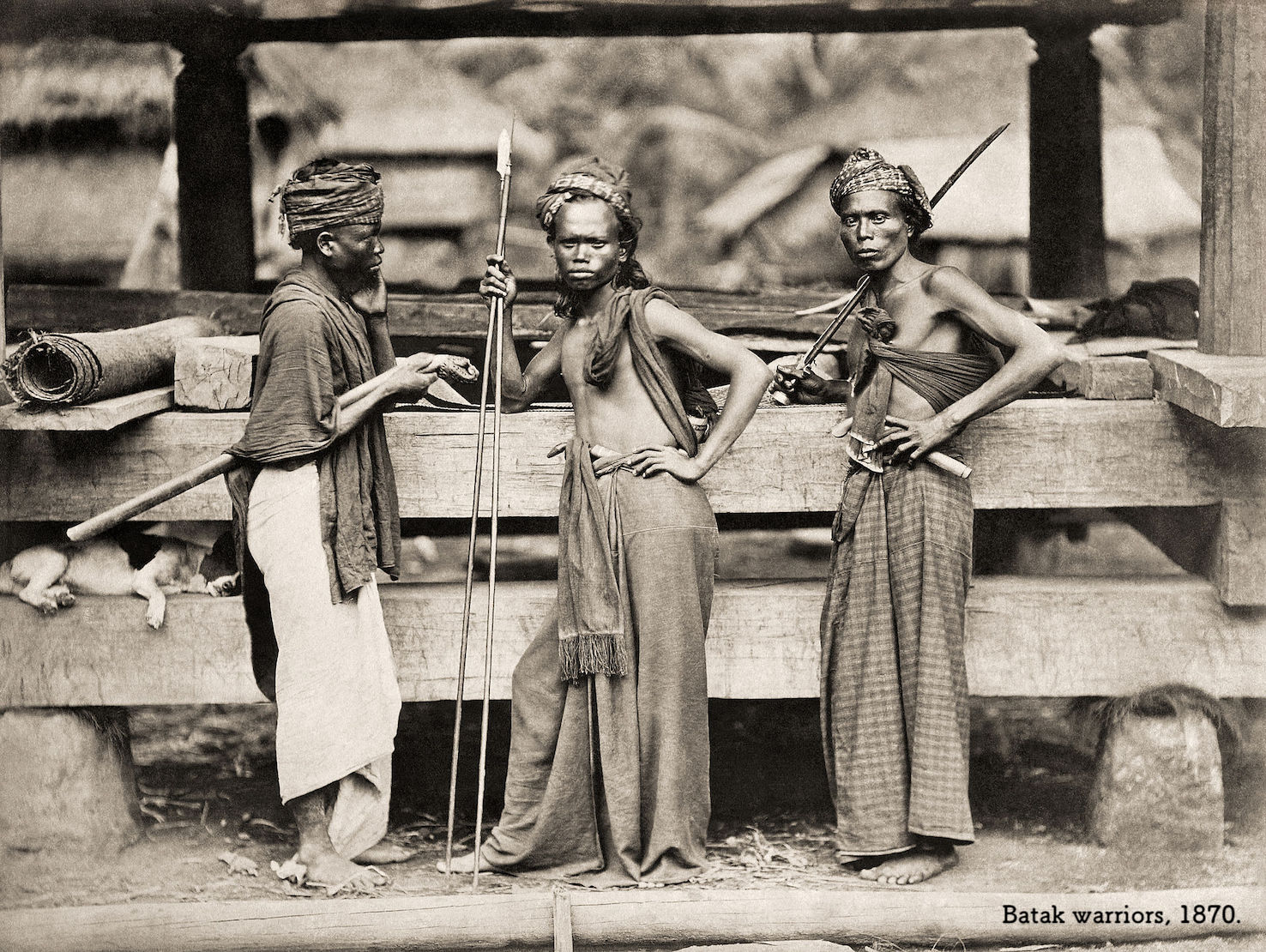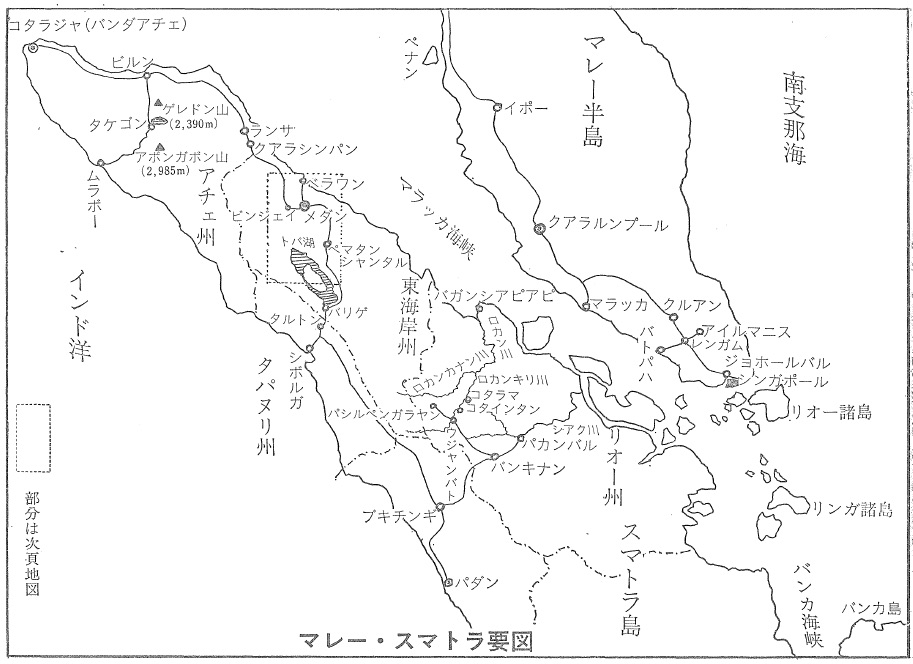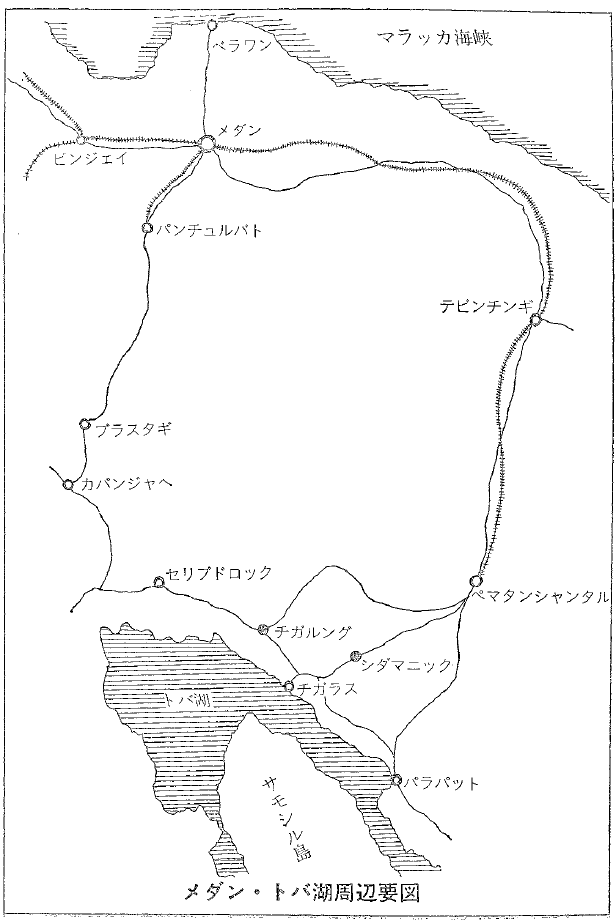バタックの儀礼的カニバリズム
Ritualized
Cannibalism among the Batak

バタックの儀礼的カニバリズム
Ritualized
Cannibalism among the Batak

バタックの儀礼的カニバリズム(Wiki, Batak,より)
| Ritual cannibalism
was well documented among pre-colonial Batak people, being performed in
order to strengthen the eater's tendi.[23]
In particular, the blood, heart, palms and soles of the feet were seen
as rich in tendi. |
The tendi
cult.植民地時代以前のバタック族の間では儀式的な喰人はよく記録されており、食べる人のテンディを強化するために行われていた[23]。特
に、血液、心臓、手のひら、足の裏はテンディが豊富であるとみなされていた。 |
| In Marco Polo’s
memoirs of his stay on the east coast of Sumatra (then called Java
Minor) from April to September 1292, he mentions an encounter with hill
folk whom he refers to as "man-eaters".[24] From secondary sources,
Marco Polo recorded stories of ritual cannibalism among the "Battas".
Marco Polo's stay was restricted to the coastal areas, and he never
ventured inland to directly verify such claims. Despite never
personally witnessing these events, he was nonetheless willing to pass
on descriptions which were provided to him, in which a condemned man
was eaten: "They suffocate him. And when he is dead they have him
cooked, and gather together all the dead man's kin, and eat him. And I
assure you they do suck the very bones till not a particle of marrow
remains in them...And so they eat him up stump and rump. And when they
have thus eaten him they collect his bones and put them in fine chests,
and carry them away, and place them in caverns among the mountains
where no beast nor other creature can get at them. And you must know
also that if they take prisoner a man of another country, and he cannot
pay a ransom in coin, they kill him and eat him straightway.[25] |
マ
ルコ・ポーロが1292年4月から9月までスマトラ(当時は小ジャワと呼ばれていた)東岸に滞在した際の回想録の中で、彼は「人食い」と呼ぶ丘の民との遭
遇に言及している[24]。
二次資料から、マルコ・ポーロは「バッタ」たちの儀式的食人の物語を記録している。マルコ・ポーロの滞在は沿岸部に限定されており、そのような主張を直接
確かめるために内陸部に足を踏み入れたことはなかった。しかし、マルコ・ポーロは、そのような話を直接聞いたことはないにもかかわらず、「死刑囚が食べら
れた。そして、死んだら調理して、死んだ男の親族を全員集めて食べる。そして、骨髄のかけらも残らないほど骨をしゃぶり、切り株と切り株を食べ尽くす。こ
うして彼を食べると、彼らは彼の骨を集め、立派な櫃に入れて運び出し、獣も他の生き物も近づけない山の中の洞窟に置くのである。また、あなたがたは、彼ら
が他国の人を捕虜にして、その人が貨幣による身代金を支払うことができなければ、彼らはその人を殺してすぐに食べることを知らなければならない[25]。 |
| The Venetian Niccolò de' Conti
(1395–1469) spent most of 1421 in Sumatra in the course of a long
trading journey to Southeast Asia (1414–1439), and wrote a brief
description of the inhabitants: "In a part of the island
called Batech live cannibals who wage continual war on their neighbors."[26][27] |
ベ
ネチア人のニッコロ・デ・コンティ(1395-1469)は、東南アジアへの長い貿易の旅(1414-1439)の途中、1421年のほとんどをスマトラ
島で過ごし、住民の簡単な説明を書いている。「バテックと呼ばれる島の一部には、隣人に絶え間ない戦争を仕掛ける人食い人種が住んでいる」[26]
[27]と書いている。 |
| Sir
Thomas Stamford Raffles
in the 1820s studied the Batak and their rituals and laws regarding the
consumption of human flesh, writing in detail about the transgressions
that warranted such an act as well as their methods.[28] Raffles stated
that "It is usual
for the people to eat their parents when too old to work," and
that for certain crimes a criminal would be eaten alive: "The flesh is eaten raw
or grilled, with lime, salt and a little rice."[29] |
1820 年代にトマス・スタンフォード・ラッフルズ卿がバタック族とその人肉消費に関する儀式と法律を研究し、そのような行為を正当化する罪とその方法について詳 しく書いた[28]。 ラッフルズは、「人々が年を取って働けないときに両親を食べるのは普通だ」と述べ、特定の罪のために犯罪者は生きて食べられるとした。「肉は生か焼かれ、 ライム、塩、少しの米と一緒に食べられる」[29]。 |
| The German physician and
geographer Franz Wilhelm Junghuhn
visited the Batak lands between 1840 and 1841. Junghuhn says about
cannibalism among the Batak (whom he called "Battaer"): "People
do the honest Battaer an injustice when it is said that they sell human
flesh in the markets, and that they slaughter their old people as soon
as they are unfit for work...They eat human flesh only in wartime, when
they are enraged, and in a few legal instances." Junghuhn tells
how after a perilous and hungry flight he arrived in a friendly
village, and the food that was offered by his hosts was the flesh of
two prisoners who had been slaughtered the day before,[30] however he
maintains that the Batak exaggerated their love of human flesh in order
to frighten off would-be invaders and to gain occasional employment as
mercenaries for the coastal tribes who were plagued by pirates.[31] |
ド
イツの医師で地理学者のFranz Wilhelm
Junghuhuhnは、1840年から1841年にかけてバタックの土地を訪れた。ユングフンはバタック人(彼は「バタール」と呼んだ)のカニバリズム
についてこう語っている。「彼らが市場で人肉を売り、老人が仕事に適さなくなるとすぐに虐殺すると言われれば、人々は正直なバタッカーに不公平感を抱くだ
ろう...彼らが人肉を食べるのは戦時中、激怒したとき、そしてごく少数の合法な例だけだ」。ユンフン(Junghuhuhn)は、危険で空腹の飛行の
後、彼が友好的な村に到着し、彼のホストによって提供された食べ物は、前日に虐殺された2人の囚人の肉だったと伝えているが[30]、彼はバタク人が自称
侵略者を脅かすために人肉に対する彼らの愛を誇張し、海賊に悩まされていた沿岸部族の傭兵として時々仕事を獲得したと主張している[31]。 |
| Oscar
von Kessel
visited Silindung in the 1840s and in 1844 was probably the first
European to observe a Batak cannibalistic ritual in which a convicted
adulterer was eaten alive. His description parallels that of Marsden in
some important respects, however von Kessel states that cannibalism
was regarded by the Batak as a judicial act and its application was
restricted to very narrowly defined infringements of the law including
theft, adultery, spying or treason. Salt, red pepper and lemons had to
be provided by the relatives of the victim as a sign that they accepted
the verdict of the community and were not thinking of revenge.[32] |
オ
スカー・フォン・ケッセルは1840年代にシリンドゥンを訪れ、1844年におそらくヨーロッパ人として初めて、有罪判決を受けた姦通者が生きたまま食わ
れるバタック人の食人儀式を観察した。彼の記述は、いくつかの重要な点でマースデンのそれと類似しているが、フォンケッセルは、食人はバタック人によって
司法行為とみなされ、その適用は窃盗、姦通、スパイまたは反逆を含む非常に狭く定義された法律の侵害に限定されていたと述べている。被害者の親族はコミュ
ニティの判決を受け入れ、復讐を考えていないことを示すために、塩、赤唐辛子、レモンを提供しなければならなかった[32] |
| Ida Laura Pfeiffer visited the
Batak in August 1852 and although she did not observe any cannibalism,
she was told that: "Prisoners of war are tied to a tree and beheaded at once; but the blood is carefully preserved for drinking, and sometimes made into a kind of pudding with boiled rice. The body is then distributed; the ears, the nose, and the soles of the feet are the exclusive property of the Rajah, who has besides a claim on other portions. The palms of the hands, the soles of the feet, the flesh of the head, and the heart and liver, are reckoned peculiar delicacies, and the flesh in general is roasted and eaten with salt. The Regents assured me, with a certain air of relish, that it was very good food, and that they had not the least objection to eat it. The women are not allowed to take part in these grand public dinners."[33] |
Ida Laura
Pfeifferは1852年8月にバタック族を訪れ、共食いは観察しなかったが、次のようなことを聞いたという。 「捕虜は木に縛られ、すぐに首をはねられる。しかし、血は飲むために大切に保存され、時には煮た米と一緒にプディングのようなものにされる。耳、鼻、足の 裏はラジャの独占物であり、ラジャは他の部分にも権利を主張する。手のひら、足の裏、頭の肉、心臓と肝臓は特別な珍味とされ、肉は一般に焼いて塩で食べ る。摂政たちは、とても美味しい食べ物で、食べることに何の抵抗もないと、美味しそうに私に言った。このような盛大な公の晩餐会に女性が参加することは許 されていない」[33]。 |
| Samuel
Munson and Henry Lyman, American Baptist missionaries to
the Batak, were cannibalized in 1834.
Dutch and German missionaries to the Batak in the late 19th century
observed a few instances of cannibalism and wrote lurid descriptions to
their home parishes in order to raise donations for further
missions.[34] The growing Dutch influence in northern Sumatra led to
increased Malay influence in coastal trade and plantations, pushing the
Karo farther inland. Growing ethnic tensions culminated in the 1872
Karo Rebellion where the Karo were suppressed by Dutch and Malay
forces. Despite this, Karo resistance to Dutch imperialism lingered
into the early 20th century.[35] In
1890 the Dutch colonial government banned cannibalism in the regions
under their control.[36] Rumors
of Batak cannibalism survived into the early 20th century but it seems
probable that the custom was rare after 1816, due partially to the
influence of Islam.[37] |
1834
年、バタック人へのアメリカ人宣教師であるサミュエル・マンソンとヘンリー・ライマンが人肉食に遭った。19世紀後半にバタック族に派遣されたオランダ人
とドイツ人の宣教師は、食人行為のいくつかの事例を観察し、さらなる宣教のための寄付を集めるために自国の教区に下品な記述をした[34]。
スマトラ島北部でオランダの影響力が強まると、沿岸部の貿易や農園でマレーの影響が強まり、カロ族が内陸部に押しやられるようになった。民族的緊張の高ま
りは、1872年のカロの反乱で頂点に達し、カロはオランダ軍とマレー軍によって鎮圧された。1890年、オランダ植民地政府は支配下での食人を禁止した
[36]。バタック人の食人の噂は20世紀初頭まで残っていたが、1816年以降はイスラムの影響もあり、その習慣は稀であったと思われる[37]。 Kipp, R. S. (1990). The Early Years of a Dutch Colonial Mission: The Karo Field. Ann Arbor, MI: University of Michigan Press. doi:10.3998/mpub.13231 |
| https://en.wikipedia.org/wiki/Batak |
●トバ湖へのアース・ダイビング(本田忠尚『茨 木機関潜行記』図書出版、1988.より)


リンク
文献
Copyleft, CC, Mitzub'ixi Quq Chi'j, 1996-2099
☆ ☆
☆